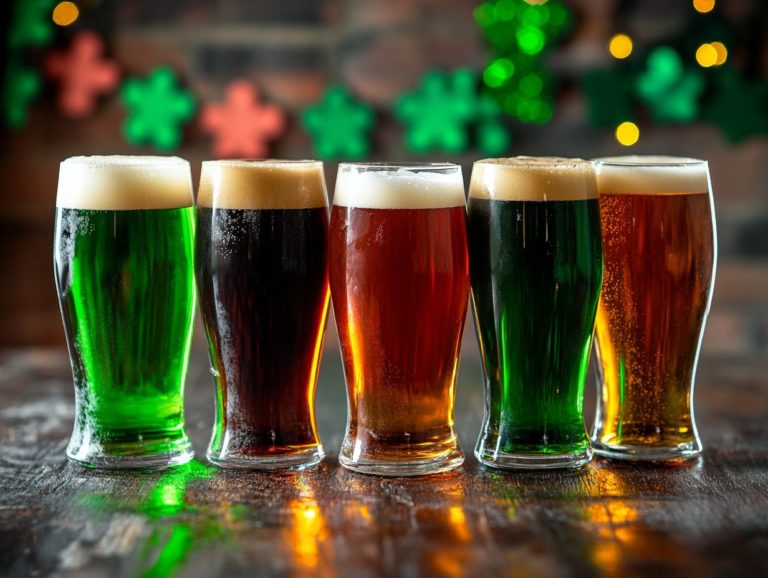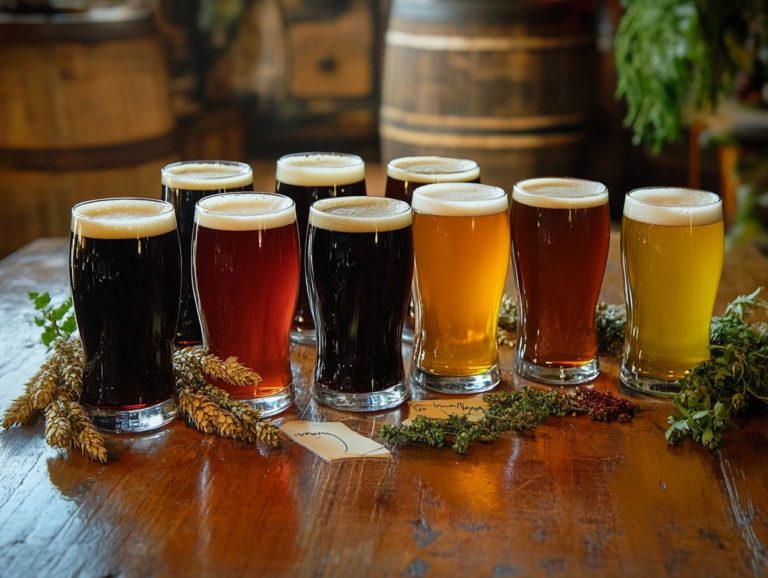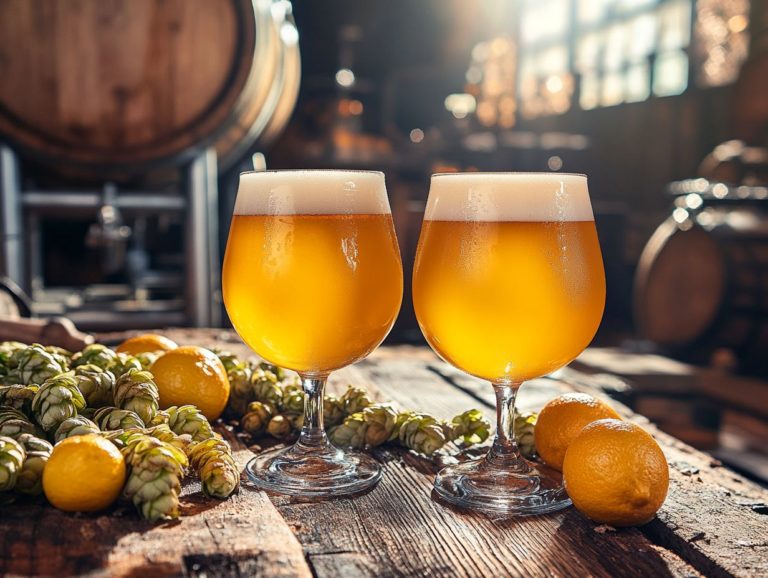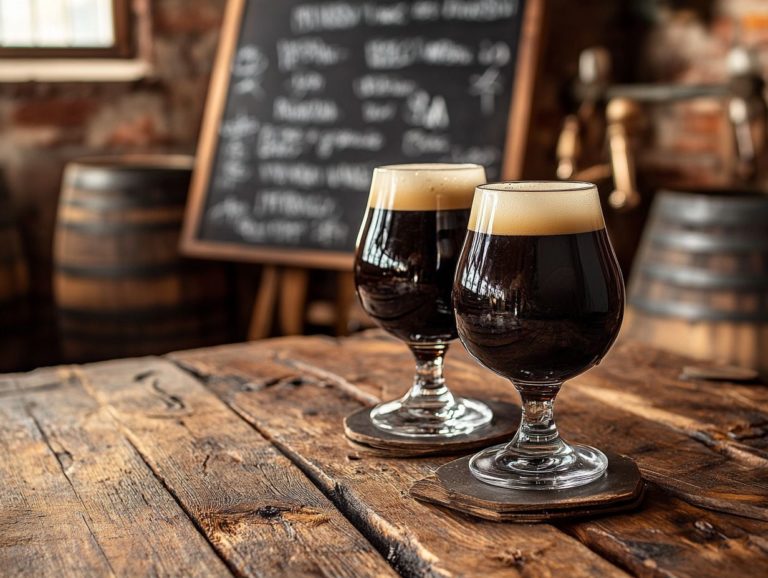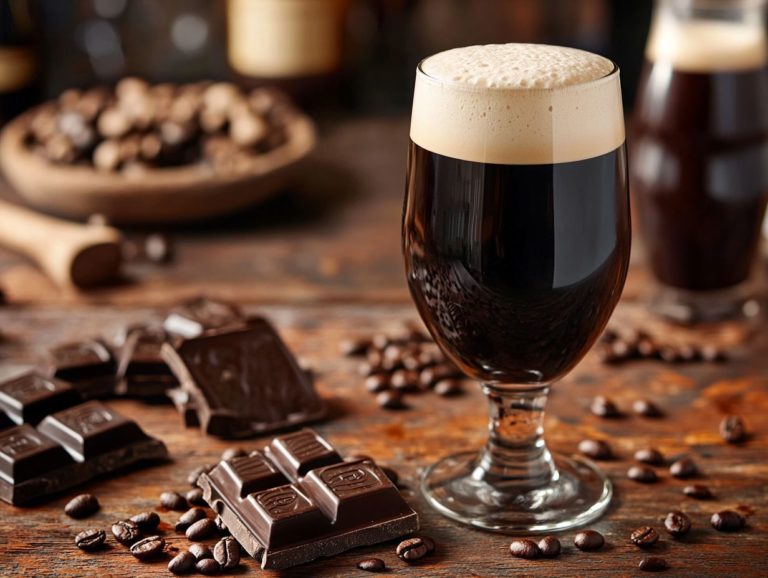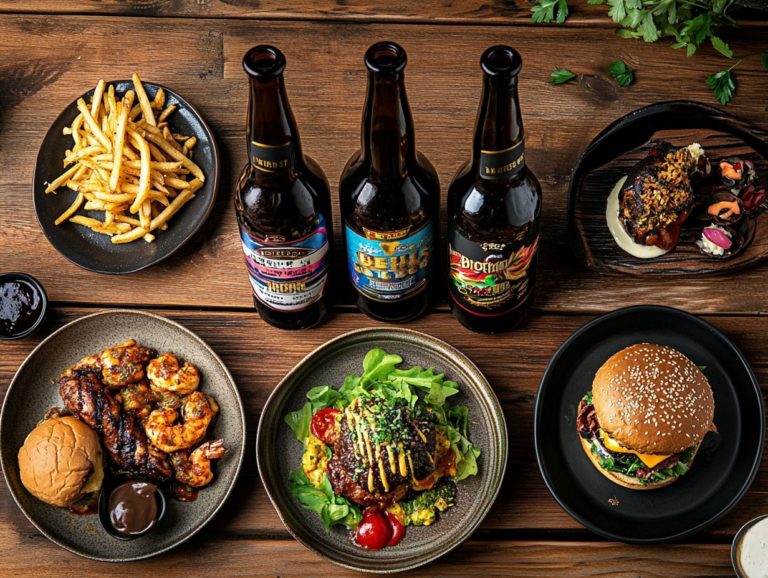Top 5 Belgian Beer Styles You Need to Try
Belgian beer stands out with its rich flavors, distinctive brewing techniques, and an array of styles that cater to every palate. From the history of Belgian beer to its unique brewing techniques, every aspect of it is fascinating.
In this article, you will delve into five iconic Belgian beer styles: Witbier, Dubbel, Tripel, Saison, and Lambic. You ll uncover what truly sets Belgian beer apart, explore the key ingredients and brewing methods, including those used in Trappist beers and Abbey Ales, and discover perfect food pairings that elevate your tasting experience.
Whether you re a seasoned connoisseur or simply curious, there s something here that will pique your interest and enhance your appreciation for this remarkable tradition.
Contents
Key Takeaways:
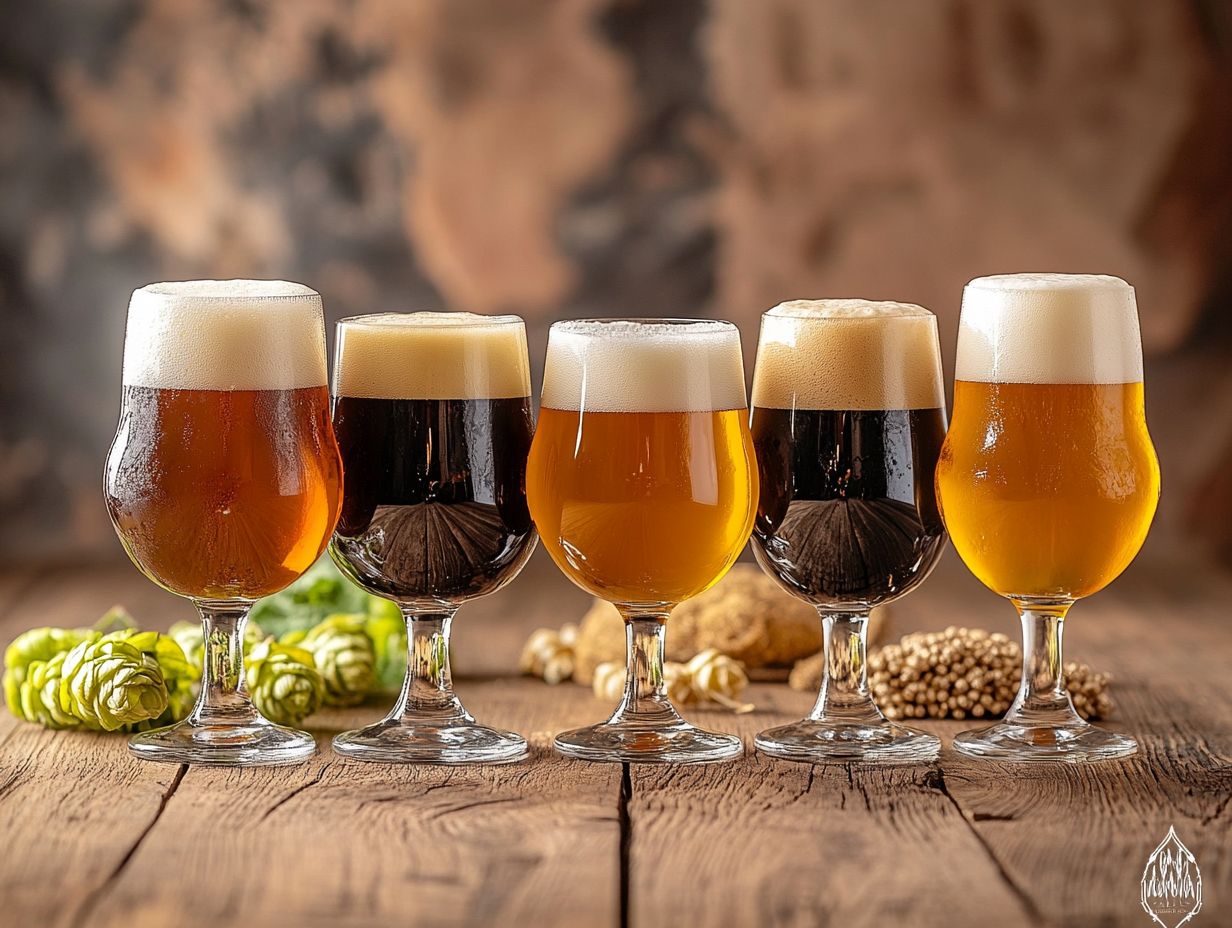
- Indulge in the refreshing and citrusy flavors of Belgian Witbier, a light and easy-to-drink beer that pairs well with seafood and salads.
- Experience the rich and malty taste of a Belgian Dubbel, a complex and full-bodied beer that complements hearty dishes like stews and roasted meats.
- Savor the golden and spicy notes of a Belgian Tripel, a strong and aromatic beer that pairs perfectly with bold flavors like cheese and charcuterie.
- Explore the robust and dark flavors of Flanders Red and Flanders Brown, known for their complex profiles and subtle sourness, making them ideal companions for rich and savory meals.
1. Belgian Witbier
Belgian Witbier, a classic beer style hailing from Belgium, is truly a delightful experience. You ll appreciate its light body, cloudy appearance, and refreshingly crisp taste.
This beer is typically crafted from a blend of malted wheat and barley, accented with a dash of spices like coriander and orange peel. This unique brewing method, steeped in centuries of tradition, showcases the exceptional quality and variety of Belgian beers, underscoring their cultural significance in Belgian cuisine and beyond.
As you pour this brew, you ll notice its pale golden hue and natural turbidity, both indicators of the impressive wheat content in the mash. On the nose, a Belgian Witbier enchants with a medley of fruity and floral aromas, where the zesty citrus beautifully intertwines with earthy spice notes.
In terms of flavor, expect a vibrant and complex profile that dances with hints of banana and clove, complemented by refreshing citrus and spice. Traditional brewing techniques often involve a cool fermentation process, which contributes to its bubbly texture. Some adventurous brewers even introduce unique herbs for an extra layer of depth.
Notable examples, such as Blanche De Bruxelles, embody this style with their exquisite balance and aromatic charm, securing their place as beloved staples in the craft beer community.
2. Belgian Dubbel
Belgian Dubbel is a rich, dark ale that enchants with its malty profile and complex flavors. Prepare to be delighted by notes of caramelized sugar and dark fruits, all wrapped in a subtle sweetness that has made this style a favorite among craft beer enthusiasts in Belgium and beyond.
With its deep amber hue and velvety mouthfeel, it offers a splendid balance of sweetness and mild bitterness. This style is one of the many iconic Belgian ales, including Tripel and Quadrupel.
Originating from the Trappist monasteries of Belgium, this beer style was crafted by monks in the Middle Ages, serving as both sustenance and a means of supporting their communities. The fermentation process often involves dark malts that imbue the ale with its signature flavors, accompanied by yeast strains that contribute depth through fruity esters and spices.
A shining example of Belgian Dubbel is St. Bernardus Abt 12, celebrated for its rich, complex taste profile featuring notes of fig, plum, and banana. Together, these elements create a symphony of layered flavors that dance on the palate. This striking combination of sweetness and a hint of bitterness makes it a beloved choice for both novice and seasoned beer drinkers alike. Many Belgian Dubbels are aged in barrels, which enhances their complex flavors.
3. Belgian Tripel
Belgian Tripel is a strong pale ale that captivates with its high alcohol content and distinctive fruity aromas, often showcasing delightful notes of banana, clove, and citrus. It’s the perfect choice for anyone eager to delve into the complexities of Belgian brewing.
Originating from the revered Trappist tradition, this style typically boasts a golden hue, a delicate hop aroma, and a refreshingly crisp finish. As you take a sip, you’ll likely notice the rich, creamy mouthfeel that accompanies a pleasant sweetness, perfectly balancing the subtle bitterness.
Historically, Tripels were brewed in monasteries, where monks sought a sustenance-rich beverage to see them through their fasting periods. This unique background sets Tripels apart from other Belgian styles.
For instance, Dubbel or Quadrupel feature darker malts and more pronounced caramel flavors. Some Tripels also use wild yeast strains, adding another layer of complexity.
Take, for instance, Orval Trappist Ale, which highlights the incredible variety within Belgian brewing, merging distinctiveness with tradition. Belgian Tripel, then, presents an intriguing fusion of strength, lightness, and layered flavors, offering an exciting experience for both seasoned aficionados and those just beginning their beer journey.
4. Belgian Saison
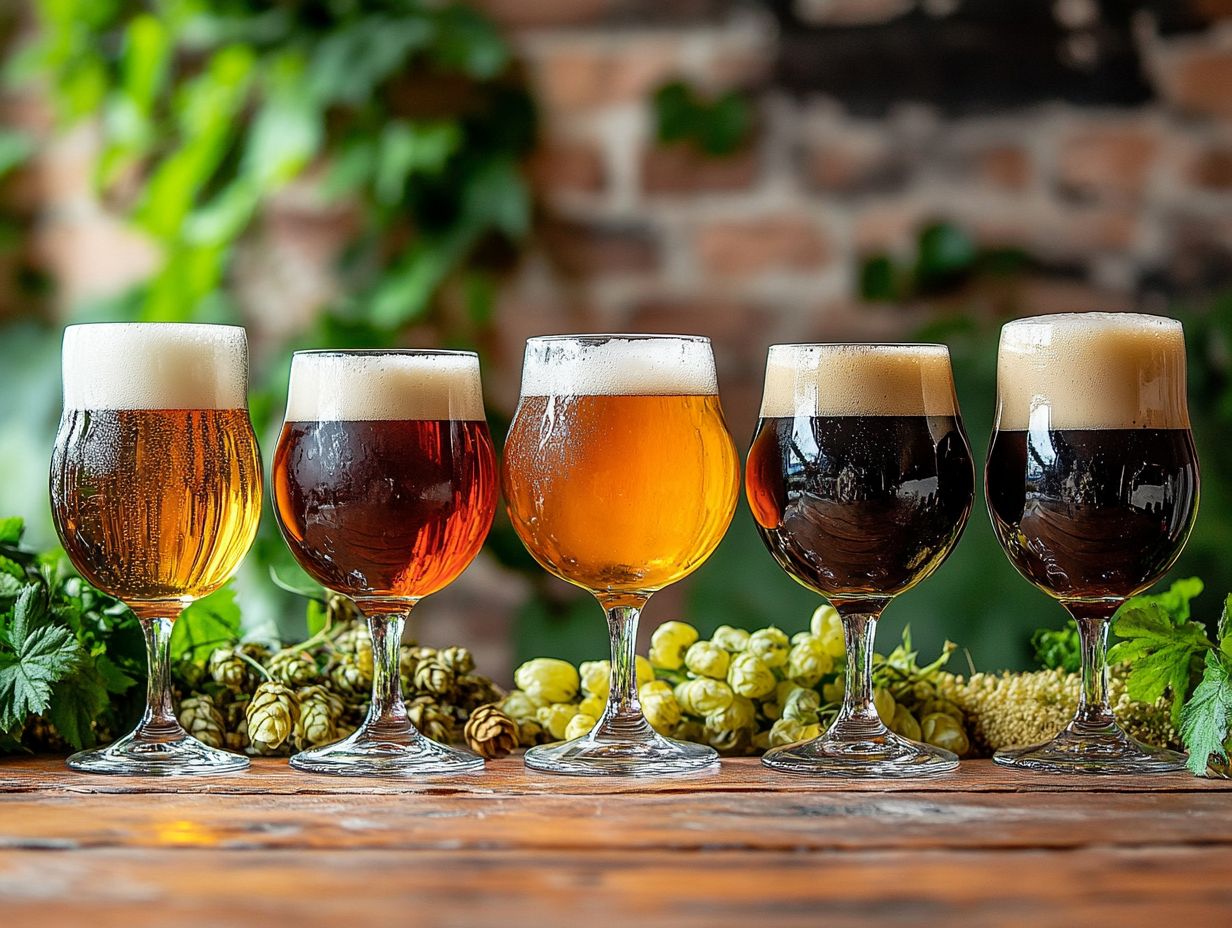
Belgian Saison, often referred to as farmhouse ale, stands out for its distinctive flavors and refreshing qualities. Its dry finish and complex aroma profile are a delightful mix of spicy, fruity, and floral notes.
Traditionally crafted in the Walloon region of Belgium during the cooler months, these ales are meant to be savored in the summer, embodying the wild yeast strains that lend them their unique character. Farmhouse ales like Saison and Bi re de Garde are cherished for their rustic and intricate flavors.
This style of beer has an intriguing history, originally created as a practical refreshment for agricultural workers seeking a low-alcohol beverage after long, grueling days in the fields. When you explore the flavor profile of a Saison, you’ll often encounter hints of orange peel, coriander, and pepper ingredients that reflect the traditional spice usage in Belgian brewing.
The influence of these brewing techniques can also be seen in other Belgian styles like Belgian Pale Ale and Belgian Blonde. Each brewery puts its own spin on this style, but a standout example is Brasserie Dupont’s Saison Dupont.
It beautifully balances earthiness with fruity esters and offers a crisp, effervescent mouthfeel, making it a quintessential representation of the genre.
5. Belgian Lambic
Belgian Lambic is a distinctive beer style that captivates with its spontaneous fermentation, a natural fermentation process that uses wild yeasts from the environment, leading to a sour and intricate flavor profile that sets it apart from the rest. This ancient and fascinating Belgian brewing method transforms the wort into a delightful symphony of flavors and aromas that can swing from fruity to funky.
The enchantment of this process doesn t merely reside in the fermentation; it thrives in the aging techniques that further refine the beer s character. You ll encounter popular variations like Gueuze a harmonious blend of young and old Lambics that experiences a secondary fermentation in the bottle and fruit Lambics, which are artfully infused with seasonal fruits like cherries or raspberries, introducing vibrant notes and a touch of sweetness.
Barrel aging plays a crucial role in developing the complex flavors of these beers. Iconic examples from Belgium, such as Cantillon s Gueuze and Brouwerij Oud Beersel s Kriek, showcase the exquisite craftsmanship that defines lambic brewing.
These selections invite you to delve into a world steeped in tradition and brimming with innovative flavors. Get ready for an unforgettable taste adventure!
What Makes Belgian Beer Unique?
Belgian beer stands as a testament to quality and diversity, rooted in a rich brewing tradition that combines traditional techniques with new methods. This results in a wide range of styles and flavors that reflect the cultural significance of beer in Belgium.
With influences from monastic breweries, local ingredients, and unique fermentation methods, Belgian beers present choices that cater to every palate, ranging from light and fruity ales to robust dark ales and everything in between. The inclusion of adjuncts extra ingredients like chocolate and pralines in some brews highlights the innovative side of Belgian beer crafting.
This intricate relationship between brewing and culture not only showcases the careful brewing of local brewers but also invites you, the beer enthusiast, to delve into distinctive regional styles. Consider the Trappist breweries like Westmalle and Chimay that create exceptional Trappist ales resonating with their monastic heritage. Lambic beers are crafted through spontaneous fermentation, embodying the unique terroir of the Brussels region and offering a characteristic sourness that tantalizes adventurous taste buds. The cultural importance of these beers underscores their place in the culinary traditions of Belgium.
Belgian white beers, or witbiers, further enrich this diverse selection. Breweries like Hoegaarden excel in creating refreshing, citrus-infused brews that have garnered international acclaim. This vibrant mix of flavors and styles makes Belgian beer incredibly exciting, not merely as a beverage but as a vital component of the country s cultural identity.
Key Ingredients of Belgian Beer
The key ingredients in Belgian beer are high-quality malt, hops, yeast, and water, each playing a vital role in shaping the final flavor and character of the brew. This meticulous emphasis on quality is a hallmark of Belgian beer culture.
You ll often find that many Belgian beers incorporate unique adjuncts such as spices, fruits, and sugars, which enhance their complexity and appeal. From the iconic Belgian Pale Ale to the seasonal brews, these ingredients are pivotal.
The malt provides a solid backbone, imparting both sweetness and color, while the hops introduce a bitterness that beautifully balances the brew. Yeast is crucial during fermentation, contributing those distinctive fruity or spicy notes you may recognize in different Belgian styles, like the famed Tripel or Dubbel. The purity and mineral content of the water can subtly influence the mouthfeel and overall taste, making it an essential player in the brewing process. This combination is what makes Belgian beer so unique, blending tradition with local ingredients.
Using local or traditional ingredients allows brewers to elevate these characteristics and explore regional flavors. For instance, the addition of Belgian candi sugar, often found in Belgian strong ales, enhances the alcohol content and creates a rich, smooth profile. This showcases how innovative adjuncts can beautifully complement classic styles, resulting in an experience that s both familiar and refreshingly unique. The brewing techniques used maintain the quality and diversity of Belgian beer, ensuring each brew stands out.
Discover these amazing flavors today!
How Are Belgian Beers Different from Other Beer Styles?
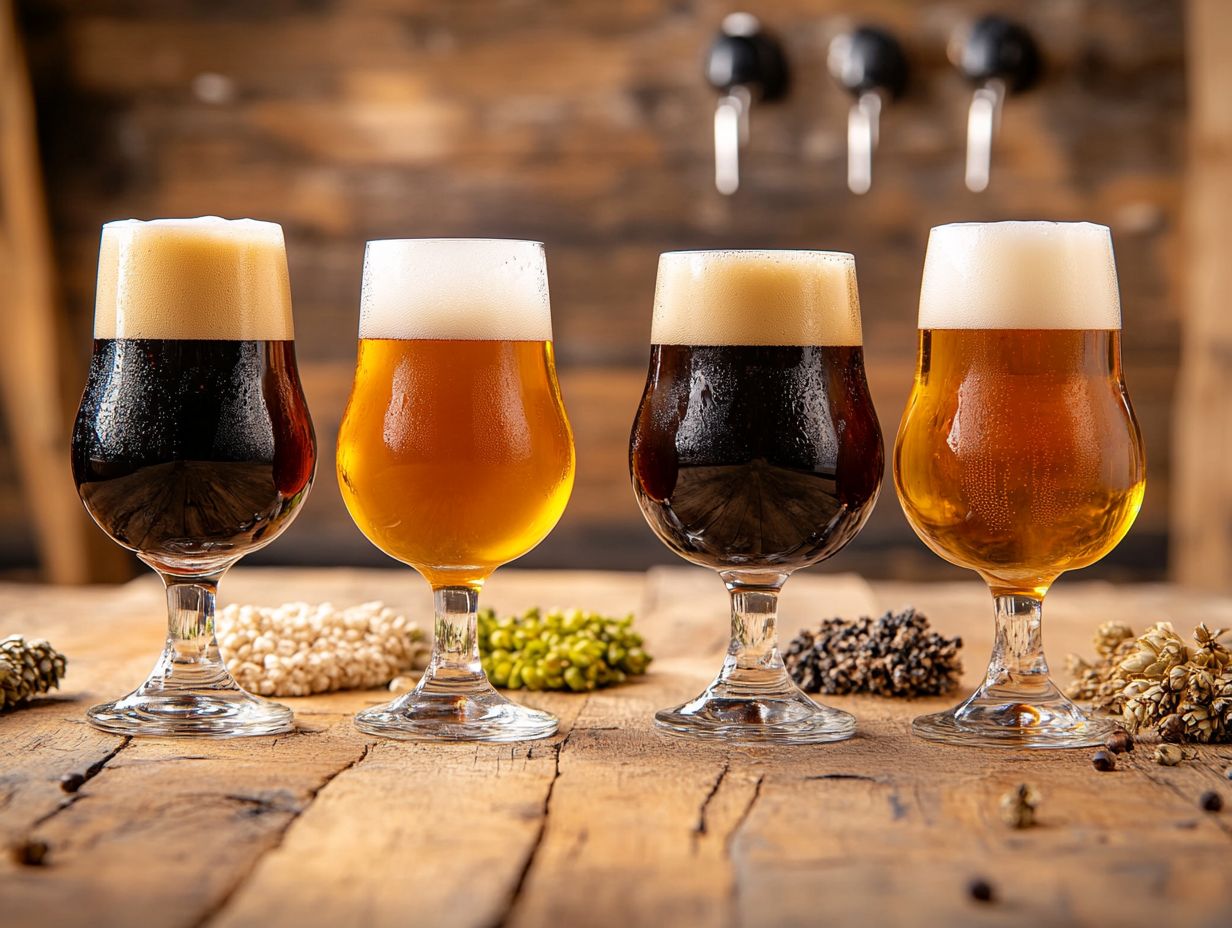
Belgian beers truly set themselves apart from other styles through a commitment to traditional brewing techniques that often embrace unique fermentation processes and an array of ingredients, all contributing to their remarkable flavors and aromas.
The use of wild yeasts and a natural fermentation process where yeasts in the air contribute to the brewing, along with the incorporation of spices, creates a distinctive character. This results in a fascinating spectrum of styles that satisfy various palates. For instance, Abbey Ales, which are rich and complex, are celebrated not only across Belgium but also beyond its borders.
Unlike the more straightforward brewing methods found in lagers or IPAs, which typically emphasize a balance between hops and malt, Belgian brewers delve into complexity by layering flavors. Take, for example, a classic Tripel; it boasts a richness that melds alcohol with fruity esters and a touch of spiciness, delivering a depth that may surprise anyone accustomed to more conventional beer styles.
The unique flavors of Belgian beers, from strong dark ales to refreshing Belgian Pale Ales, offer something extraordinary for every beer enthusiast.
The addition of candied sugars and diverse malt caramelization techniques brings unparalleled richness and complexity to these brews, guiding you on an expansive taste journey. This intricate approach not only elevates the beer’s profile but also forges a deep connection with regional traditions, giving you a unique glimpse into the cultural essence of Belgium.
The history of beer in Belgium is rich with innovation, from the famous Trappist beers to the distinctive flavors of farmhouse ales like Saison and Bi re de Garde.
What Are the Best Food Pairings for Belgian Beer?
Belgian beer offers you an extraordinary versatility when it comes to food pairings, showcasing a diverse range of flavors that complement an impressive array of dishes from rich chocolate desserts and artisanal pralines to classic Belgian French fries.
The complex profiles of Belgian beers not only enhance but also elevate your culinary experiences, making them ideal companions for various cuisines. Whether you’re enjoying a refreshing beer like Saison Dupont or a robust Quadrupel, there’s a Belgian beer that complements every meal.
Consider, for instance, a fruity and spicy Belgian Dubbel. It pairs beautifully with stoofvlees, a traditional Flemish beef stew, as the beer’s malt sweetness perfectly balances the savory richness of the dish. Similarly, a crisp and refreshing Saison enhances the flavors of moules-frites, that beloved combination of mussels and fries, thanks to its effervescence that cuts through the creaminess of the accompanying garlic mayo.
The versatility of Belgian beers like Flanders Red and Flanders Brown adds a unique dimension to the culinary experience.
In terms of desserts, a dark, rich Quadrupel complements chocolate mousse splendidly. The deep caramel notes of the beer echo the vibrant flavors of dark chocolate, creating a truly indulgent experience.
These thoughtful pairings showcase how the nuances in Belgian beer can elevate your dining experience, transforming every meal into a delightful culinary journey. Don’t miss out on experiencing these incredible flavors! Whether it’s a classic Dubbel or an innovative Witbier, Belgian beer styles offer endless possibilities for enhancing your meals.
What Are the Different Methods of Brewing Belgian Beer?
What Are the Different Methods of Brewing Belgian Beer?
Belgian brewing techniques are a world unto themselves, rich in diversity and often featuring methods like spontaneous fermentation, barrel aging, and distinctive yeast strains. These methods combine to create the unique complexity and character we love in Belgian beers.
As a craft beer enthusiast, you ll appreciate how brewers in Belgium often try new things, experimenting with these traditional techniques to craft innovative products that honor the past while welcoming new flavors and styles. The monastic breweries, famous for producing Trappist beers (beers made in monasteries by Trappist monks), exemplify the cultural importance and dedication to quality.
Take spontaneous fermentation, for example. It introduces wild yeast strains and bacteria that add a delightful tartness and depth, hallmarks of styles like Lambic. Then there s barrel aging, which not only imparts those alluring woodsy notes but also allows for secondary fermentation, resulting in a luxurious, creamy mouthfeel. A prime illustration of this is Cantillon s Gueuze, a masterpiece that showcases the intricate possibilities these methods can achieve.
The best Belgian beers often undergo intricate processes, resulting in unparalleled quality and diversity.
Some breweries also use specific yeast strains that produce fruity esters and spicy phenols, layering flavors that tantalize your palate. The interplay of these techniques culminates in a rich tapestry of aromas and tastes, offering beer aficionados like you an endless array of delightful options to explore. Seasonal brews such as Winter Ales and refreshing beers like Belgian Blonde ensure that there’s always something new and exciting to discover.
How Can You Identify a High-Quality Belgian Beer?
Identifying a high-quality Belgian beer requires you to consider several key factors, such as its appearance, aroma, flavor profile, and mouthfeel, while also understanding the brewing process that contributes to its overall quality. As a discerning beer enthusiast, you can utilize a tasting guide to assess the complexity and balance of flavors, ranging from fruity to malty notes, ensuring that each sip offers a satisfying experience. A comprehensive beer guide will help you explore the best Belgian beers available at your local bottle shop.
Among the standout styles, Trappist ales captivate with their deep, rich profiles, boasting layers of dark fruit, caramel, and spice. When evaluating these, pay attention to the varying levels of sweetness and the warming finish that beautifully complements their robust character. Notable examples include Orval Trappist Ale and St. Bernardus Abt 12, both celebrated for their exceptional quality.
Saison, on the other hand, showcases a delightful blend of earthy and citrus flavors that can vary widely. Watch the beer s carbonation, as it can significantly enhance its refreshing qualities. Don t forget to assess the mouthfeel higher-quality Belgian beers often deliver a smooth, velvety texture that beckons you for another sip. Examples like Saison Dupont and Brasserie Dupont are perfect illustrations of these exceptional qualities.
Ultimately, recognizing these attributes will elevate your tasting experience into a delightful exploration of Belgian craftsmanship. A beer catalog featuring tasting notes can be a valuable resource for both seasoned enthusiasts and newcomers alike.
Frequently Asked Questions
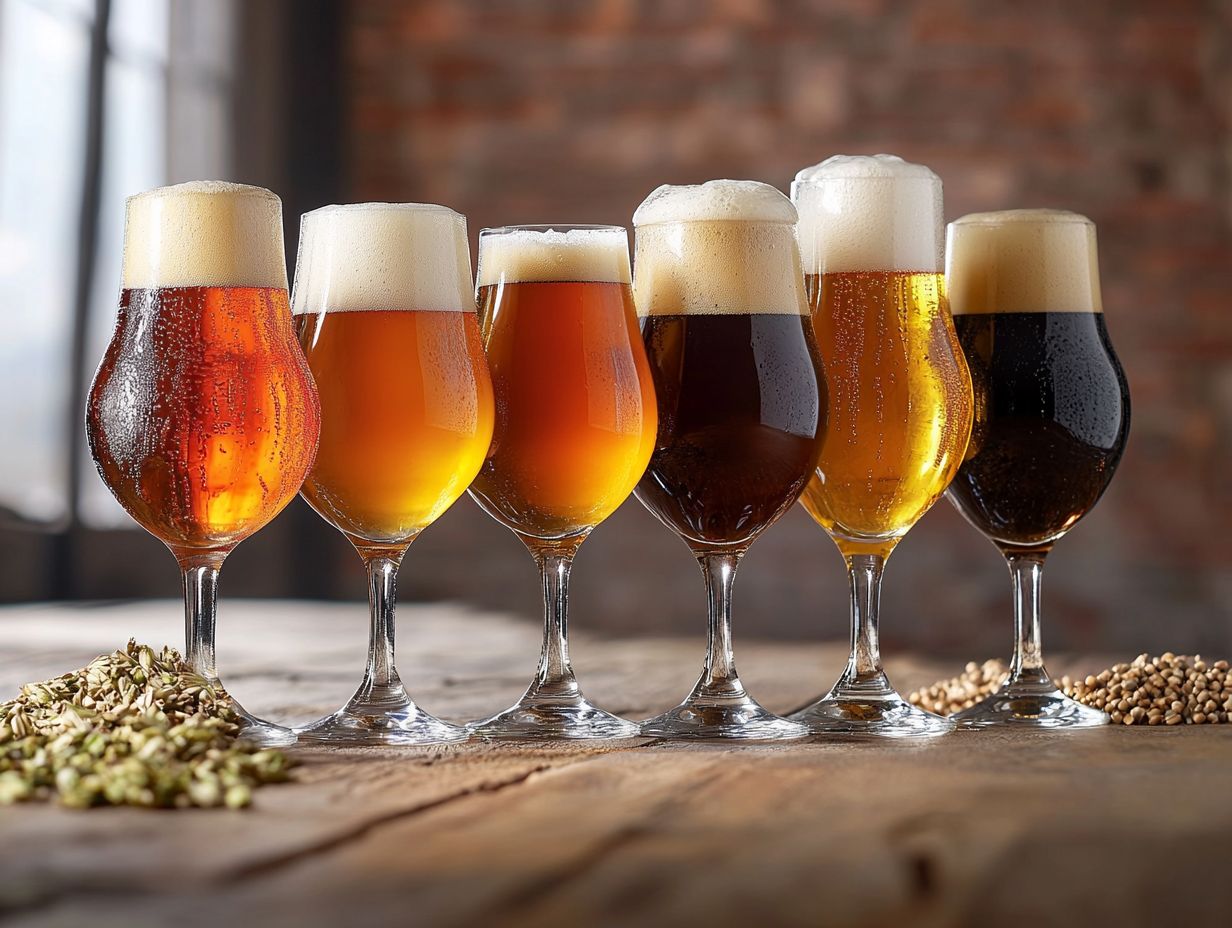
What are the top 5 Belgian beer styles to try?
Here are the top 5 Belgian beer styles to try: Belgian Dubbel, Belgian Tripel, Belgian Witbier, Belgian Saison, and Belgian Lambic. Each of these styles offers a unique glimpse into the rich tapestry of Belgian beer, from the fruity aromas of a Tripel to the sour complexity of a Lambic.
What makes Belgian beer styles unique?
Belgian beer styles are unique because they often use unconventional ingredients such as spices, herbs, and fruits, and they also use open fermentation and bottle conditioning methods. The cultural importance of these traditional styles is evident in every sip, reflecting centuries of brewing heritage in Belgium.
Exploring Belgian Beer Styles
Are all Belgian beer styles strong in alcohol content?
No, not all Belgian beer styles are strong in alcohol content.
Some styles, like Belgian Tripel and Belgian Golden Strong Ale, can have a high ABV of 8-10%. However, lighter styles such as Belgian Witbier and Belgian Saison have an ABV of 5-6%. This diversity includes low-alcohol beers that still deliver rich and complex flavors.
Which Belgian beer style pairs well with food?
Experience the joy of pairing Belgian Dubbel with your favorite dishes! Its malty sweetness and subtle fruitiness complement a wide range of meals, from roasted meats to chocolate desserts.
The versatility of Belgian beer makes it a perfect choice for any culinary occasion.
Can I find these Belgian beer styles outside of Belgium?
Yes, you can find these Belgian beer styles in many countries around the world.
Belgian beers are highly sought after and are often available in specialty beer stores and bars that focus on craft and imported beers. Local bottle shops frequently carry a variety of Belgian beers, ensuring you can enjoy these remarkable brews wherever you are.
Is there a specific glassware that is used for serving Belgian beer styles?
Yes, Belgian beer styles are traditionally served in their own unique glassware.
For example, Belgian Dubbel is typically served in a goblet, while Belgian Witbier is served in a tall, curved glass called a weizen glass. Proper glassware enhances the hop aroma and overall tasting experience, bringing out the best in each beer.

